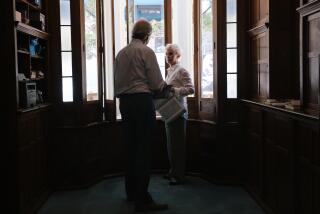A Marketing Guru for Business of Religion
- Share via
Does “Southwind” make you think of a contemporary music ensemble or some low-alcohol wine?
Maybe. But what it doesn’t suggest is a conservative Presbyterian church in affluent Encinitas, north of San Diego. George Barna, perhaps the world’s foremost expert on church marketing, knows this for a fact.
“People said it sounded like a cult,” he says.
Barna doesn’t just test-market church names. In his book, “Marketing the Church,” he tells pastors and church elders that he’s writing “to help you reach the people in your community and congregation as cost-effectively and meaningfully as might be done by McDonald’s, Procter & Gamble, or American Airlines.”
Religion is a major enterprise in this state, and somewhat controversially, Barna trumpets the message of marketing to evangelical churches all over the country. He uses computers, demographics, telephone polling and all the other tools normally used to market soap powder and spark plugs. But he uses them to promote “our core product--salvation through a personal relationship with Jesus Christ.”
Robert D. Hisrich, a marketing professor at the University of Tulsa and co-author of “Marketing Your Ministry,” pronounces all this “a California phenomenon.”
If it is, Barna is its guru. The Glendale consulting firm that bears his name also works for secular clients--they’ve included Disney Channel, May Co., Visa and the city of Glendale--which pay the bills. But Barna and all his full-time staff are born-again Christians. Church marketing is their main thrust.
It’s easy to dismiss Barna as the latest crass example of marketing gone mad. “Your church can be the Chrysler of tomorrow,” he writes, perhaps with unintended prescience. And: “The Bible is one of the world’s great marketing texts.” And: “Jesus Christ was a communications specialist.”
But not so fast. Using marketing, the 36-year-old Barna gets pastors to think about what they’re trying to do and write a statement of purpose. He makes them listen to their flock. He gets them to try to meet real needs without, he insists, compromising church teachings.
OK, a pie-chart in one of his reports is titled “After Life Expectations of Churched and Unchurched” (36% of L.A. County expects to go to heaven).
But that same report (“We Have Seen the Future: The Demise of Christianity in Los Angeles County”) is full of careful research about who lives in the county and what attitudes they hold about God, religion and churches, broken down by age, race, ethnicity and so forth. There’s also data on how and why people select a given church.
This isn’t so far-fetched. Churches have been advertising for a long time--not very usefully, Barna says--and marketing long ago moved past widgets and beer to deal with cultural, aesthetic and therapeutic experiences, says Steve Tipton, a professor of religion and sociology at Emory University. “We’re marketing all kinds of ideals all the time.”
Therein lies the rub. George Lindbeck, a Yale University theology historian, says marketing to some means excluding others, and besides, “What people want isn’t always good.”
“You know what’s scary about this to me?” asks theologian Fisher Humphreys at Samford University’s Beeson Divinity School in Birmingham, Ala. “That the people who are doing it might not be aware there’s a risk.”
Church marketing advocates insist that they know the risks. But nowadays, people don’t automatically follow their parents into a church--especially in mobile, free-thinking California. People marry across faiths too.
Thus, to Ken Capps, associate pastor at Hope Chapel in Hermosa Beach, it’s sheer sentimentality to consider marketing impious. Barna says the Apostles did it. He says Paul pioneered direct mail.
Twenty-year-old Hope Chapel is a great place to see marketing in action. Originally a surfer church--it held services right on the beach--it now has a full-time “pastor of communications,” as well as its own graphics department and printing presses. Using demographic data from Church Information & Development Services, a private concern in Costa Mesa, Hope has developed 60 different ministries, including jogging, skiing and substance abuse, to grab its yuppie target audience.
The church sells T-shirts and bumper stickers and makes sure its bathrooms are clean. For mailings, it uses a computerized database (it has three full-time computer staffers). New residents are invited by letter and get a coupon for a free book from the Hope Chapel bookstore. After a visit, they get a phone call from a pastor and a follow-up letter.
By videotaping services, the church can reach 150,000 homes on cable TV. There is a van service for the handicapped, and a flourishing divorce-recovery ministry.
(Hope’s annual budget approaches $4 million, raised mostly through tithing by parishioners.)
New Hope Chapels are always springing up; founders get a marketing class, as well as help with advertising, demographics, logos, stationery and press releases.
Hope Chapel Gateway in Torrance began building interest before it opened through a series of local newspaper ads. Wordlessly, the first ones just showed a dove, the church’s logo. Gradually, on succeeding days, the ad’s purpose was revealed; opening day brought throngs.
Barna’s clients say marketing helps them with their message. Tim Logerquist, who heads an association of 28 Southern Baptist congregations from Malibu to Santa Barbara, says Barna’s work for the group “was an eye-opener.”
Barna surveyed local residents on Southern Baptism (75% didn’t even know what it was) and asked people what they might want in a church. As a result, Logerquist says, the association’s once-stagnant churches will expand child care, initiate programs for teen-agers, start support groups and reach out to other denominations. Churches are formulating their own vision statements too.
“It’s caused our churches and their leadership to become very intentional,” Logerquist says. “They know what their purpose is.”
More to Read
The biggest entertainment stories
Get our big stories about Hollywood, film, television, music, arts, culture and more right in your inbox as soon as they publish.
You may occasionally receive promotional content from the Los Angeles Times.










